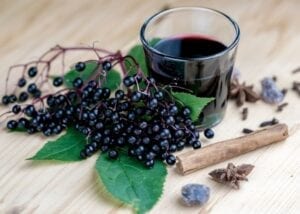
In a 2012 study published by Bioscience, Biotechnology, and Biochemistry, researchers evaluated the therapeutic potential of elderberry juice against the human influenza-A virus. Results indicated that elderberry juice suppressed viral proliferation in the bronchial fluid of infected laboratory mice. Further, oral administration of elderberry juice increased influenza-neutralizing antibodies in bronchoalveolar lavage fluids in vivo. Researchers concluded that elderberry juice might be capable of stimulating an immune response and inhibiting viral replication of influenza-A infection in humans.
Studies have also validated elderberry liquid extract’s inhibitory effect against the human influenza-B virus. A 2011 study published by BMC Complementary and Alternative Medicine found that elderberry liquid extract yielded antimicrobial activity against various types of pathogenic bacteria, including Streptococcus Pyogenes, Branhamella catarrhalis, and both human influenza type A and B in vitro.
I hope this information helps you find your solution, and I can’t wait to show you more! Follow us on FB and sign up for our newsletter.
My passion is your Solution,
![]()